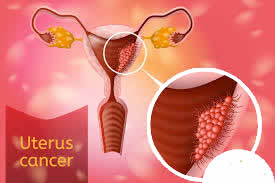Table of Contents
Basic Information About Uterine Cancer
Cancer of the uterus occurs when abnormal cells develop and begin growing out of control.
There are two main types of uterine cancer. Endometrial cancers begin in the lining of the uterus (endometrium) and account for about 95% of all cases; and uterine sarcomas, which develop in the muscle tissue (myometrium), and is a rarer form of uterine cancer.
What Are the Symptoms of Uterine Cancer?
Unusual vaginal bleeding is the most common symptom of uterine cancer, particularly any bleeding after menopause. Some women experience a watery discharge, which may have an offensive smell. Less common symptoms include unexplained weight loss, difficulty urinating, or abdominal pain.
While these symptoms may be caused by other reasons, check with your doctor or health care provider if you are concerned.
Causes of Uterine Cancer
Some factors that can increase your risk of uterine cancer include:
- being postmenopausal, or reaching menopause late (after age 55)
- a thickened wall lining (endometrial hyperplasia)
- never having children
- starting periods early (before age 12)
- having high blood pressure or diabetes
- being overweight or obese
- family history of ovarian, uterine, or bowel cancer
- having a genetic condition such as Cowden syndrome or Lynch syndrome
- previous ovarian tumours, or polycystic ovary syndrome
- using oestrogen only hormone replacement therapy or fertility treatment.
- previous radiation therapy to the pelvis
- taking tamoxifen to treat breast cancer (the benefits of treating breast cancer usually outweigh the risk of uterine cancer (talk to your doctor if you are concerned).
Diagnosis of uterine cancer
Tests to diagnose uterine cancer include:
Physical examination
The doctor may check your abdomen for swelling. To check your uterus, the doctor will place two fingers inside your vagina while pressing on your abdomen, or they may use an instrument (a speculum) that separates the walls of the vagina (similar to a cervical screening test).
Transvaginal ultrasound
Using ultrasound with a device called a transducer, the doctor can see the size of your ovaries, uterus, and the thickness of the endometrium. If anything appears unusual, the doctor may suggest a biopsy.
Endometrial biopsy
An endometrial biopsy is done in the specialist’s office. A long, thin tube (pipelle) is inserted into your vagina to suck cells from the uterine lining. The cells are sent to a pathologist who examines them under a microscope. There may be some discomfort similar to period cramps so your doctor may suggest taking non-steroidal anti-inflammatory drugs such as ibuprofen, before the procedure.
Hysteroscopy and biopsy
A hysteroscope is a telescope-like device which is inserted through your vagina into your uterus and allows a gynaecologist or gynaecological oncologist to see inside your uterus. During this procedure, tissue can also be removed (biopsy) and sent for further testing in a laboratory.
Blood and urine tests
Blood and urine tests may be used to assess your general health and inform treatment decisions.
Other tests
If cancer is detected in your uterus, you may have other scans to see if the cancer has spread to other parts of your body, such as an x-ray, CT scan or MRI scan. For particular types of uterine cancer, such as sarcoma, a PET scan may be used.
After a diagnosis of uterine cancer
After being diagnosed with cancer the uterus, you may feel shocked, upset, anxious or confused. These are normal responses. A diagnosis of uterine cancer affects each person differently. For most it will be a difficult time, however some people manage to continue with their normal daily activities.
You may find it helpful to talk about your treatment options with your doctors, family and friends. Ask questions and seek as much information as you feel you need. It is up to you as to how involved you want to be in making decisions about your treatment.
Treatment for uterine cancer
Surgery (hysterectomy and bilateral salpingo-oophorectomy)
The most common form of treatment for cancer of the uterus is surgically removing the uterus and cervix. This procedure is called a total hysterectomy. If the fallopian tubes and both ovaries are also removed, it is called a bilateral salpingo-oophorectomy.
Ovaries are often removed to reduce the risk of the cancer coming back, as ovaries produce oestrogen, a hormone that may cause the cancer to grow.
Radiation therapy (radiotherapy)
Radiation therapy, the use of x-rays to kill or injure cancer cells, is commonly used as an additional treatment to reduce the chance of the cancer coming back. It may be recommended as the main treatment if you are not well enough for surgery.
Radiation therapy is given either externally, where a machine directs radiation at the cancer and surrounding tissue; or from inside the body (brachytherapy), where radioactive material is put in thin tubes and placed near the cancer internally.
Radiation therapy to the pelvic region may cause menopause, therefore, if you are concerned about how treatment will affect your fertility, it is important to raise your concerns with your treatment team before treatment commences.
Hormone therapy
Hormone therapy is usually given if the cancer has spread or if the cancer has come back (recurred). It is also sometimes used if surgery is not an option. Progesterone is the main hormone treatment for women with uterine cancer, and it is available in tablet form or by injection. It helps shrink some cancers and to control symptoms.
Chemotherapy
Chemotherapy is used to treat certain types of uterine cancer, or when cancer comes back after surgery or radiotherapy, or if the cancer is not responding to hormone treatment. It can be used to control the cancer and to relieve symptoms.
Palliative care
In some cases of uterine cancer, your medical team may talk to you about palliative care. Palliative care aims to improve your quality of life by alleviating symptoms of cancer.
As well as slowing the spread of uterine cancer, palliative treatment can relieve pain and help manage other symptoms.

